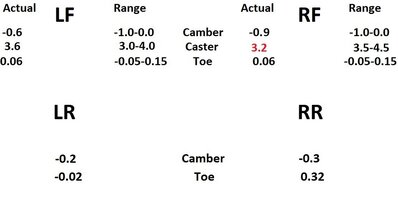DucatiSS said:
What was the air pressure when they were hot/warm?
Pressure when I checked the temp was 36, however it was believed the cold pressure was set at 34 by the shop when I had the tires installed, I was thinking that 2 PSI was a small jump for a warm tire. Very well could have been but when I checked them the next morning they were at 32. This easily could have been the difference from mid-day to early morning ambient temps...so temp change was 4 PSI which is normal.
DucatiSS said:
Is the amount of rubber the same on the edge vs. the center?
I would speculate yes since they are new but after 250 miles I would hope any small ridges should be at least worn somewhat even...or hope so.
Chickenhawk said:
Just be careful that you are not reading too much accuracy into an infrared gun. Race teams actually use a sharp temperature probe inserted into the tread to measure temperature to a tenth of a degree.
The reading from the IR gun was jumping a little but I averaged the temp the best I could, the second test I used my temp probe from my Fluke meter and it was much more stable. I rounded the temps slightly unles they were at .5 but most were +- .2 of a whole number. I checked temps with the IR gun as well and the temps while were as consistent...were about 1.5-2 deg higher, temps shown were from the Fluke probe.
The second test I set the cold temp in the AM at 35 PSI for all 4 and checked when I left work.....pressure was the same. I was on the interstate for about 40 miles and when I came off the exit, I checked the pressure and was at 38 PSI for all 4. Trying to get home to see the kids so I didn't take a temp reading.
Upon reaching the house, I checked the pressure and it was down to 37 for all 4 and I probed the tread about 1/8" deep.....results were interesting.
The right rear has more negative camber and more toe-out, resulting in the inside of that tire to be the warmest. The fronts both were warmer on the inside but not much. The RF caster is out so I suspect the ball joints could be the culprit, camber was in spec but different from the left.
Granted I need to take more readings and average them out but for a preliminary test it's a good start. I want to say the axle bearings may be worn to give the different alignment values and I do remember a very small amount of play in the bearings last time I checked....didn't think they would change the angle as much as they have...unless there is another problem.
Here are the temps when I arrived home, I also added the alignment report.
-------------------LF---------------------------------------------RF----------------------------
-----------84------80-----88------------------------------85-----82-----83
>
>
>
>
>------------------LR---------------------------------------------RR-------------------------------
>----------83------82-----88------------------------------89-----85-----84-------------------

 Is the edge temp suppose to be the same as the center? Is the amount of rubber the same on the edge vs. the center? Would that have any bearing on the temps?
Is the edge temp suppose to be the same as the center? Is the amount of rubber the same on the edge vs. the center? Would that have any bearing on the temps? 
